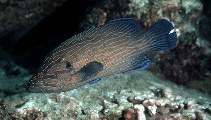http://www.fishbase.org/Summary/speciesSummary.php?genusname=Cephalopholis&speciesname=formosa ---> http://192.134.151.83/Summary/speciesSummary.php?genusname=Cephalopholis&speciesname=formosa
http://192.134.151.83/Summary/speciesSummary.php?genusname=Cephalopholis&speciesname=formosa ---> https://fishbase.mnhn.fr/Summary/speciesSummary.php?genusname=Cephalopholis&speciesname=formosa
https://fishbase.mnhn.fr/Summary/speciesSummary.php?genusname=Cephalopholis&speciesname=formosa ---> https://fishbase.mnhn.fr/summary/Cephalopholis-formosa.html
Cephalopholis formosa, Bluelined hind : fisheries

You can
sponsor
this page
Common name (e.g. trout)
Genus + Species (e.g. Gadus morhua)
-

-
About this page
-
Languages
-
User feedbacks
-
Citation
-
Uploads
-
Related species
-


 Bluelined hind
Add your observation in
Fish Watcher
Upload your
photos
and
videos
Bluelined hind
Add your observation in
Fish Watcher
Upload your
photos
and
videos
Pictures
|
Videos |
Google image
 Cephalopholis formosa
Cephalopholis formosa
Picture by
Randall, J.E.
Teleostei (teleosts) >
Perciformes/Serranoidei
(Groupers) >
Epinephelidae
(Groupers)
Etymology:
Cephalopholis:
Greek, kephale = head + Greek, pholis = scale (Ref.
45335
)
.
More on author:
Shaw
.
Environment: milieu / climate zone / depth range / distribution range
Ecology
Marine; reef-associated; non-migratory; depth range 1 - 30 m (Ref.
89707
), usually 1 - 15 m (Ref.
90102
). Tropical; 36°N - 34°S, 30°E - 143°E (Ref.
5222
)
Indo-West Pacific: western India to Philippines, north to southern Japan (Honshu), south to northern Australia. '
Epinephelus formosus
' from Madagascar (Ref.
6457
), Réunion and Mauritius (Ref.
6458
) are probably based on misidentifications of
Cephalopholis polleni
. Confused with
Cephalopholis boenak
.
Length at first maturity / Size / Weight / Age
Maturity: L
m
17.0
range ? - ? cm
Max length : 34.0 cm TL male/unsexed; (Ref.
4787
)
Dorsal
spines
(total): 9;
Dorsal
soft rays
(total): 15-17;
Anal
spines
: 3;
Anal
soft rays
: 7 - 8. Characterized by: dark brown to yellowish brown color with narrow blue stripes; body with ctenoid scales, including abdomen; greatest depth of body 2.5-2.9 in SL; rounded caudal fin; pelvic fins, 1.6-2.0 in head length (Ref.
90102
): head length 2.4-2.6 in SL; preorbital depth 3.6-4.3% SL, more than half maxilla width; convex interorbital area; rounded preopercle, finely serrate, lower edge fleshy; smooth subopercle and interopercle; maxilla naked, reaching to or just past vertical at rear edge of eye (Ref.
089707
).
Like
C. boenak
, it prefers shallow dead or silty reefs and this may account for the primarily continental distributions of these two species. Solitary (Ref 90102).
Life cycle and mating behavior
Maturity
|
Reproduction
|
Spawning
|
Eggs
|
Fecundity
|
Larvae
Heemstra, P.C. and J.E. Randall
, 1993. FAO Species Catalogue. Vol. 16. Groupers of the world (family Serranidae, subfamily Epinephelinae). An annotated and illustrated catalogue of the grouper, rockcod, hind, coral grouper and lyretail species known to date. Rome: FAO. FAO Fish. Synop. 125(16):382 p. (Ref.
5222
)
IUCN Red List Status (Ref.
130435
)
Least Concern (LC)
; Date assessed:
02 November 2017
CITES
Not Evaluated
Not Evaluated
Threat to humans
Harmless
Human uses
Fisheries: subsistence fisheries
FAO - Publication:
search
|
FishSource
|
More information
Countries
FAO areas
Ecosystems
Occurrences
Introductions
Stocks
Ecology
Diet
Food items
Food consumption
Ration
Common names
Synonyms
Metabolism
Predators
Ecotoxicology
Reproduction
Maturity
Spawning
Spawning aggregation
Fecundity
Eggs
Egg development
Age/Size
Growth
Length-weight
Length-length
Length-frequencies
Morphometrics
Morphology
Larvae
Larval dynamics
Recruitment
Abundance
BRUVS
References
Aquaculture
Aquaculture profile
Strains
Genetics
Electrophoreses
Heritability
Diseases
Processing
Nutrients
Mass conversion
Collaborators
Pictures
Stamps, Coins Misc.
Sounds
Ciguatera
Speed
Swim. type
Gill area
Otoliths
Brains
Vision
Tools
E-book
|
Field guide
|
Identification keys
|
Length-frequency wizard
|
Life-history tool
|
Point map
|
Classification Tree
|
Catch-MSY
|
Special reports
Check for Aquarium maintenance
|
Check for Species Fact Sheets
|
Check for Aquaculture Fact Sheets
Download XML
Summary page
|
Point data
|
Common names
|
Photos
Internet sources
AFORO (otoliths)
|
Aquatic Commons
|
BHL
|
Cloffa
|
BOLDSystems
|
Websites from users
|
Check FishWatcher
|
CISTI
|
Catalog of Fishes
:
genus
,
species
|
DiscoverLife
|
ECOTOX
| FAO - Publication:
search
|
Faunafri
| Fishipedia |
Fishtrace
| GenBank:
genome
,
nucleotide
| GloBI |
Google Books
|
Google Scholar
|
Google
|
IGFA World Record
|
MitoFish
|
National databases
|
Otolith Atlas of Taiwan Fishes
|
Public aquariums
|
PubMed
|
Reef Life Survey
| Socotra Atlas |
Tree of Life
| Wikipedia:
Go
,
Search
| World Records Freshwater Fishing |
Zoological Record
Estimates based on models
Preferred temperature (Ref.
123201
): 26.5 - 29.3, mean 28.7 °C (based on 2081 cells).
Phylogenetic diversity index (Ref.
82804
): PD
50
= 0.5000 [Uniqueness, from 0.5 = low to 2.0 = high].
Bayesian length-weight: a=0.01000 (0.00620 - 0.01613), b=2.97 (2.84 - 3.10), in cm total length, based on LWR estimates for this species & Genus-body shape (Ref.
93245
).
Trophic level (Ref.
69278
): 4.1 ±0.7 se; based on size and trophs of closest relatives
Resilience (Ref.
120179
): Medium, minimum population doubling time 1.4 - 4.4 years (Fec = 80,208).
Fishing Vulnerability (Ref.
59153
): Low vulnerability (24 of 100).
Price category (Ref.
80766
):
Very high
.
Nutrients (Ref.
124155
): Calcium = 54 [30, 97] mg/100g; Iron = 0.577 [0.329, 1.080] mg/100g; Protein = 18.5 [16.7, 20.2] %; Omega3 = 0.16 [0.10, 0.25] g/100g; Selenium = 29.7 [16.5, 50.7] μg/100g; VitaminA = 181 [65, 556] μg/100g; Zinc = 0.823 [0.596, 1.337] mg/100g (wet weight);
Back to Search
Random Species
Back to Top
Accessed through:
Not available
FishBase mirror site :
localhost
Page last modified by :
mrius-barile
- 20 July 2016
Fatal error
: Uncaught ArgumentCountError: Too few arguments to function checkEcotox(), 1 passed in /var/www/html/summary/speciessummary.php on line 2304 and exactly 3 expected in /var/www/html/includes/speciessummary.lib.php:2579 Stack trace: #0 /var/www/html/summary/speciessummary.php(2304): checkEcotox() #1 {main} thrown in
/var/www/html/includes/speciessummary.lib.php
on line
2579
|